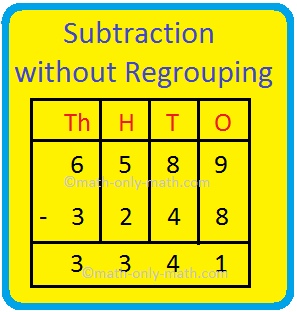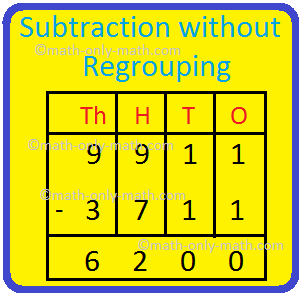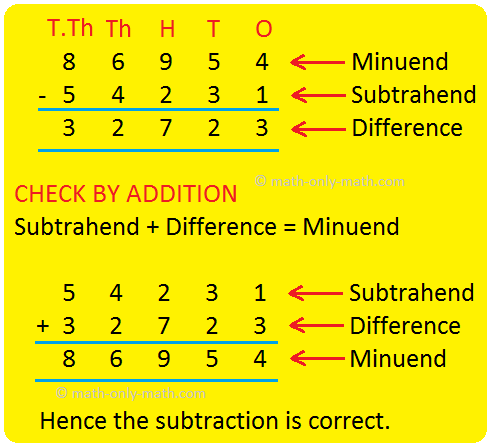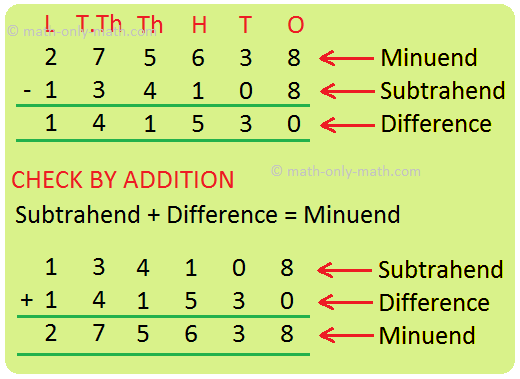Subscribe to our ▶️ YouTube channel 🔴 for the latest videos, updates, and tips.
Subtraction without Regrouping
We will learn subtracting 4-digit, 5-digit and 6-digit numbers without regrouping.
We learnt about subtraction of numbers up to 3-digits.
In a subtraction problem, the larger number from which we subtract the other number (the smaller number) is called minuend, the number (the smaller number) which is subtracted is called subtrahend and the result of subtraction is called the difference.
Here, we shall learn subtraction of 4-digit numbers.
Let us have a quick review of what we have learnt about subtraction.
Subtraction of 4-Digit Numbers without Regrouping Video
Subscribe to our ▶️ YouTube channel 🔴 for the latest videos, updates, and tips.
We first arrange the numbers one below the other in place value columns and then subtract the digits under each column as shown in the following examples.
Solved Examples on Subtraction of 4-Digit Numbers without Regrouping:
1. Subtract 3248 from 6589.
Solution:
|
Step I: Arrange the numbers vertically. Step II: Subtract ones. 9 – 8 = 1 one. Write 1 in ones column. Step III: Subtract the tens. 8 – 4 = 4 tens.. Write 4 in tens column. Step IV: Subtract the hundreds. 5 – 2 = 3 hundreds. Write 3 in hundreds column. Step V: Subtract the thousands. 6 – 3 = 3 thousands. Write 3 in thousands column. |
Thus, 6589 – 3248 = 3341. |
2. Subtract 3711 from 9911.
Solution:
|
Step I: Arrange the numbers vertically. Step II: Subtract ones. 1 – 1 = 0 one. Write 0 in ones column. Step III: Subtract the tens. 1 – 1 = 0 tens.. Write 0 in tens column. Step IV: Subtract the hundreds. 9 – 7 = 2 hundreds. Write 2 in hundreds column. Step V: Subtract the thousands. 9 – 3 = 6 thousands. Write 6 in thousands column. |
Thus, 9911 – 3711 = 6200. |
3. Subtract 3022 from 9547.
Solution:
Step I: Arrange the numbers in columns.
|
Th |
H |
T |
O | ||
|
9 |
5 |
4 |
7 | ||
|
- |
3 |
0 |
2 |
2 |
|
|
|
|
|
|
Step II: Subtracting ones, we have
|
Th |
H |
T |
O | ||
|
9 |
5 |
4 |
7 | ||
|
- |
3 |
0 |
2 |
2 |
|
|
|
|
|
5 |
Step III: Subtracting tens, we have
|
Th |
H |
T |
O | ||
|
9 |
5 |
4 |
7 | ||
|
- |
3 |
0 |
2 |
2 |
|
|
|
|
2 |
5 |
Step IV: Subtracting hundreds, we have
|
Th |
H |
T |
O | ||
|
9 |
5 |
4 |
7 | ||
|
- |
3 |
0 |
2 |
2 |
|
|
|
5 |
2 |
5 |
Step V: Subtracting thousands, we have
|
Th |
H |
T |
O | ||
|
9 |
5 |
4 |
7 | ||
|
- |
3 |
0 |
2 |
2 |
|
|
6 |
5 |
2 |
5 |
Hence, 9,547 - 3,022 = 6,525
(Six thousand, five hundred twenty-five)
Solved Examples on Subtraction of 5-Digit Numbers without Regrouping:
1. Subtract 54231 from 86954.
Solution:
|
Step I: Subtract ones. 4 – 1 = 3. Write 3 under ones. Step II: Subtract tens. 5 – 3 = 2. Write 2 under tens. Step III: Subtract hundreds. 9 – 2 = 7. Write 7 under hundreds. Step IV: Subtract thousands. 6 – 4 = 2. Write 2 under thousands. Step V: Subtract ten thousands. 8 – 5 = 3. Write 3 under ten thousands. Therefore, the difference is 32723 |
Solved Examples on Subtraction of 6-Digit Numbers without Regrouping:
1. Subtract 134108 from 275638
Solution:
|
Step I: Subtract ones. 8 – 8 = 0. Write 0 under ones. Step II: Subtract tens. 3 – 0 = 3. Write 3 under tens. Step III: Subtract hundreds. 6 – 1 = 5. Write 5 under hundreds. Step IV: Subtract thousands. 5 – 4 = 1. Write 1 under thousands. Step V: Subtract ten thousands. 7 – 3 = 4. Write 4 under ten thousands. Step VI: Subtract lakhs. 2 – 1 = 1. Write 1 under lakhs. Therefore, the difference is 141530 |
Worksheet on Subtraction without Regrouping:
I. Subtract the following:
(i) 2031 from 4351
(ii) 5374 from 6497
(iii) 6699 from 7799
(iv) 4563 from 6683
(v) 1710 from 4810
(vi) 8452 from 8475
(vii) 7233 from 9644
(viii) 2152 from 8597
(ix) 1651 from 3984
(x) 1041 from 2854
(xi) 5006 from 5816
II. Subtract without regrouping or borrowing:
|
(i) Th H T O 9 8 6 4 - 7 2 1 0 ________________ |
(ii) Th H T O 7 6 2 6 - 4 3 1 2 ________________ |
|
(iii) Th H T O 8 5 6 9 - 5 2 2 4 ________________ |
(iv) Th H T O 6 6 4 8 - 2 6 2 4 ________________ |
|
(v) Th H T O 4 8 6 7 - 3 5 3 ________________ |
(vi) Th H T O 6 7 4 6 - 3 7 2 2 ________________ |
|
(vii) Th H T O 4 9 1 7 - 6 0 2 ________________ |
(viii) Th H T O 8 1 4 9 - 4 1 0 3 ________________ |
III. Arrange in columns and subtract:
(i) 9,284 - 2,003
(ii) 4,321 - 1,210
(iii) 8,492 - 4,281
(iv) 8,379 - 6,054
IV. Find the difference between:
(i) 4,256 and 6,469
(ii) 6,876 and 3,302
(iii) 2,514 and 4,838
(iv) 6,315 and 4,100
V. Subtract without regrouping:
4 7 8 9 9 4
- 1 6 8 9 5 4
_______________
VI. Fill in the blanks:
(i) 875 – 0 = ………………
(ii) 6473 – 1 = ………………
(iii) 7899 – 7899 = ………………
(iv) 9879 – 6729 = ………………
VII. Find the Number:
540 less than 45940
VIII. Subtract without regrouping the following. Write the answer in figures:
(i) Two thousand, seven hundred eighty-five - One thousand, five hundred twenty-two
(ii) Eight thousand, six hundred ninety-nine - Six thousand, two hundred thirty-one
(iii) Seven thousand, five - Four thousand, two
(iv) Five thousand, five hundred fifty-nine - Three thousand, two hundred fifty
(v) Seven thousand, nine hundred ninety-nine - Four thousand, two hundred fifty-two
(vi) Three thousand, nine hundred fifty-five - Two thousand, one hundred twenty-five
IX. Given below is the number of people visiting the zoo in a week. Observe the data and answer the following questions:
|
Days Monday Tuesday Wednesday Thursday Friday Saturday Sunday |
Number of People Visiting the Fair 3630 4850 3395 980 6978 8580 4850 |
(i) On which day there were minimum numbers of visitors?
(ii) On which two days, the number of visitors visiting the ’Zoo’ is same?
(iii) How many more visitors were there on Saturday than Tuesday?
(iv) Which day had more visitors Monday or Wednesday? By how many?
Answers:
I. (i) 2320
(ii) 1123
(iii) 1100
(iv) 2120
(v) 3100
(vi) 23
(vii) 2411
(viii) 6445
(ix) 2333
(x) 1813
(xi) 810
II. (i) 2654
(ii) 3314
(iii) 3345
(iv) 4024
(v) 4514
(vi) 6024
(vii) 4315
(viii) 4091
III. (i) 7812
(ii) 3671
(iii) 3111
(iv) 2325
IV. (i) 2213
(ii) 3574
(iii) 2324
(iv) 2215
V. 310040
VI. (i) 875
(ii) 6472
(iii) 0
(iv) 3150
VII. 45400
VIII. (i) 1263
(ii) 2468
(iii) 3003
(iv) 2309
(v) 3747
(vi) 1830
IX. (i) Thursday
(ii) Tuesday and Sunday
(iii) 3730
(iv) Monday, 235
4th Grade Math Activities
From Subtraction without Regrouping to HOME PAGE
Didn't find what you were looking for? Or want to know more information about Math Only Math. Use this Google Search to find what you need.






New! Comments
Have your say about what you just read! Leave me a comment in the box below. Ask a Question or Answer a Question.